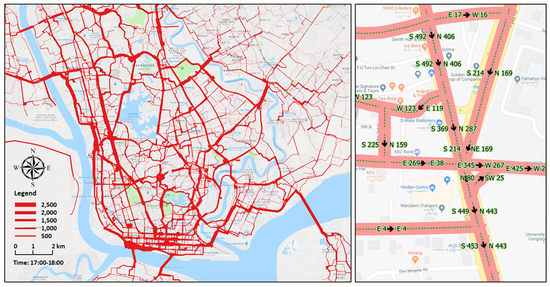Estimation of Hourly Link Population and Flow Directions from Mobile CDR
Abstract
:1. Introduction
2. Study Area
3. List of Data
4. Methodology
4.1. Research Flow
4.2. MPT CDR Data Preprocessing
4.3. Home User-Based CDR Data Magnification Factor
4.4. Hourly Link Population and Flow Directions
5. Results and Discussion
6. Conclusions
Author Contributions
Funding
Acknowledgments
Conflicts of Interest
References
- Chen, C.; Zhang, D.; Zhou, Z.H.; Li, N.; Atmaca, T.; Li, S. B-Planner: Night bus route planning using large-scale taxi GPS traces. In Proceedings of the 2013 IEEE International Conference on Pervasive Computing and Communications (PerCom), San Diego, CA, USA, 18–22 March 2013; pp. 225–233. [Google Scholar]
- Van Oudheusden, D.L.; Zhu, W. Trip frequency scheduling for bus route management in Bangkok. Eur. J. Oper. Res. 1995, 83, 439–451. [Google Scholar] [CrossRef]
- Etemad, M.; Júnior, A.S.; Matwin, S. Predicting Transportation Modes of GPS Trajectories using Feature Engineering and Noise Removal. In Advances in Artificial Intelligence: Proceedings of the 31st Canadian Conference on Artificial Intelligence, Canadian AI 2018, Toronto, ON, Canada, 8–11 May 2018; Springer International Publishing: New York, NY, USA, 2018; p. 31. [Google Scholar]
- Wang, J.; Mao, Y.; Li, J.; Xiong, Z.; Wang, W. Predictability of Road Traffic and Congestion in Urban Areas. PLoS ONE. 2015. [Google Scholar] [CrossRef] [PubMed]
- Stute, M.; Maass, M.; Schons, T.; Hollick, M. Reverse Engineering Human Mobility in Large-scale Natural Disasters. In Proceedings of the 20th ACM International Conference on Modelling, Analysis and Simulation of Wireless and Mobile Systems—MSWiM 17, Miami, FL, USA, 21–25 November 2017. [Google Scholar]
- Batran, M.; Mejia, M.; Kanasugi, H.; Sekimoto, Y.; Shibasaki, R. Inferencing Human Spatiotemporal Mobility in Greater Maputo via Mobile Phone Big Data Mining. ISPRS Int. J. Geo-Inf. 2018, 7, 259. [Google Scholar] [CrossRef]
- Caceres, N.; Wideberg, J.; Benitez, F. Deriving origin-destination data from a mobile phone network. IET Intell. Transp. Syst. 2007. [Google Scholar] [CrossRef]
- Friedrich, M.; Immisch, K.; Jehlicka, P.; Otterstätter, T.; Schlaich, J. Generating Origin-Destination Matrices from Mobile Phone Trajectories. Transp. Res. Rec. J. Transp. Res. Board. 2010, 2196, 93–101. [Google Scholar] [CrossRef]
- Iqbal, M.S.; Choudhury, C.F.; Wang, P.; González, M.C. Development of origin–destination matrices using mobile phone call data. Transp. Res. Part C Emerg. Technol. 2014, 40, 63–74. [Google Scholar] [CrossRef] [Green Version]
- Mellegard, E.; Moritz, S.; Zahoor, M. Origin/Destination-estimation Using Cellular Network Data. In Proceedings of the 2011 IEEE 11th International Conference on Data Mining Workshops, Vancouver, BC, Canada, 11 December 2011. [Google Scholar]
- Zin, T.; Kyaing, D.; Lwin, K.; Sekimoto, Y. Estimation of Originating-Destination Trips in Yangon by Using Big Data Source. J. Disaster Res. 2018, 13, 6–13. [Google Scholar] [CrossRef]
- Kang, C.; Gao, S.; Lin, X.; Xiao, Y.; Yuan, Y.; Liu, Y.; Ma, X. Analyzing and geo-visualizing individual human mobility patterns using mobile call records. In Proceedings of the International Conference on Geoinformatics, Beijing, China, 18–20 June 2010; pp. 1–7. [Google Scholar]
- Kyaing, D.; Lwin, K.; Sekimoto, Y. Human Mobility Patterns for Different Regions in Myanmar Based on CDRs Data. IPTEK J. Proc. Ser. 2017. [Google Scholar] [CrossRef]
- Wu, W.; Xu, J.; Zeng, H.; Zheng, Y.; Qu, H.; Ni, B.; Yuan, M.; Ni, L.M. Telcovis: Visual exploration of co-occurrence in urban human mobility based on telco data. IEEE Trans. Vis. Comput. Graph. 2016, 22, 935–944. [Google Scholar] [CrossRef] [PubMed]
- Gao, S.; Liu, Y.; Wang, Y.; Ma, X. Discovering Spatial Interaction Communities from Mobile Phone Data. Trans. GIS 2013, 17, 463–481. [Google Scholar] [CrossRef]
- Han, Q. Social Influence Analysis Using Mobile Phone Dataset. In Proceedings of the 2016 17th IEEE International Conference on Mobile Data Management (MDM), Porto, Portugal, 13–16 June 2016. [Google Scholar]
- Ratti, C.; Frenchman, D.; Pulselli, R.M.; Williams, S. Mobile Landscapes: Using Location Data from Cell Phones for Urban Analysis. Environ. Plan. B Plan. Des. 2006, 33, 727–748. [Google Scholar] [CrossRef]
- Dan, Y.; He, Z. A dynamic model for urban population density estimation using mobile phone location data. In Proceedings of the 2010 5th IEEE Conference on Industrial Electronics and Applications, Taichung, Taiwan, 15–17 June 2010. [Google Scholar]
- Ricciato, F.; Widhalm, P.; Pantisano, F.; Craglia, M. Beyond the “single-operator, CDR-only” paradigm: An interoperable framework for mobile phone network data analyses and population density estimation. Pervasive Mob. Comput. 2017, 35, 65–82. [Google Scholar] [CrossRef]
- Castillo, E.; Gallego, I.; Menéndez, J.M.; Jiménez, P. Link Flow Estimation in Traffic Networks on the Basis of Link Flow Observations. J. Intell. Transp. Syst. 2011, 15, 205–222. [Google Scholar] [CrossRef]
- Doblas, J.; Benitez, F.G. An approach to estimating and updating origin-destination matrices based upon traffic counts preserving the prior structure of a survey matrix. Transp. Res. Part B. 2005, 39, 565–591. [Google Scholar] [CrossRef]
- Asakura, Y.; Hato, E.; Kashiwadani, M. Origin-destination matrices estimation model using automatic vehicle identification data and its application to the Han-Shin expressway network. Transportation. 2000, 27, 419–438. [Google Scholar] [CrossRef]
- Calabrese, F.; Lorenzo, G.D.; Liu, L.; Ratti, C. Estimating Origin-Destination Flows Using Mobile Phone Location Data. IEEE Pervasive Comput. 2011, 10, 36–44. [Google Scholar] [CrossRef] [Green Version]
- Hasegawa, Y.; Sekimoto, Y.; Kashiyama, T.; Kanasugi, H. Transportation Melting Pot Dhaka: Road-link Based Traffic Volume Estimation from Sparse CDR Data. In Proceedings of the First International Conference on IoT in Urban Space, Rome, Italy, 27–28 October 2014. [Google Scholar]
- Wang, P.; Hunter, T.; Bayen, A.M.; Schechtner, K.; González, M.C. Understanding Road Usage Patterns in Urban Areas. Sci. Rep. 2012. [Google Scholar] [CrossRef] [PubMed] [Green Version]
- Goodchild, M.F.; Yuan, M.; Cova, T.J. Towards a general theory of geographic representation in GIS. Int. J. Geogr. Inf. Sci. 2007, 21, 239–260. [Google Scholar] [CrossRef] [Green Version]
- Liu, L. PPFLOW: An interactive visualization system for the exploratory analysis of migration flows. Geogr. Inf. Sci. 1995, 1, 118–123. [Google Scholar] [CrossRef]
- Marble, D.F.; Gou, Z.; Liu, L.; Saunders, J. Recent advances in the exploratory analysis of interregional flows in space and time. In Innovations in GIS 4: Selected Papers from the Fourth National Conference on GIS Research UK GISRUK; Kemp, Z., Ed.; Taylor & Francis: London, UK, 1997; pp. 75–81. [Google Scholar]
- The 2014 Myanmar Population and Housing Census Report Volume 2; Department of Population, Ministry of Immigration and Population: Nay Pyi Taw, Myanmar, May 2015.
- JICA. A Strategic Urban Development Plan of Greater Yangon. 2014. Available online: http://open_jicareport.jica.go.jp/pdf/12122511.pdf (accessed on 16 November 2018).
- Lwin, K.; Sekimoto, Y.; Takeuchi, W. Development of GIS Integrated Big Data Research Toolbox (BigGIS-RTX) for Mobile CDR Data Processing in Disasters Management. J. Disaster Res. 2018, 13, 380–386. [Google Scholar] [CrossRef]
- Telenor Investor and Analyst Day in Yangon. 1 December 2016. Available online: https://www.telenor.com/wp-content/uploads/2016/12/Asia-field-trip-day-3-Myanmar.pdf (accessed on 16 November 2018).
- Mobile World Live. Myanmar’s MPT Hits 20M Subscribers Milestone. 24 May 2016. Available online: https://www.mobileworldlive.com/asia/asia-news/myanmars-mpt-hits-20m-sub-milestone/ (accessed on 16 November 2018).
- Lwin, K.; Murayama, Y. A GIS Approach to Estimation of Building Population for Micro-spatial Analysis. Trans. GIS 2009, 13, 401–414. [Google Scholar] [CrossRef]
- Lwin, K.; Hashimoto, M.; Murayama, Y. Real-Time Geospatial Data Collection and Visualization with Smartphone. J. Geogr. Inf. Syst. 2014, 6, 99–108. [Google Scholar] [CrossRef]
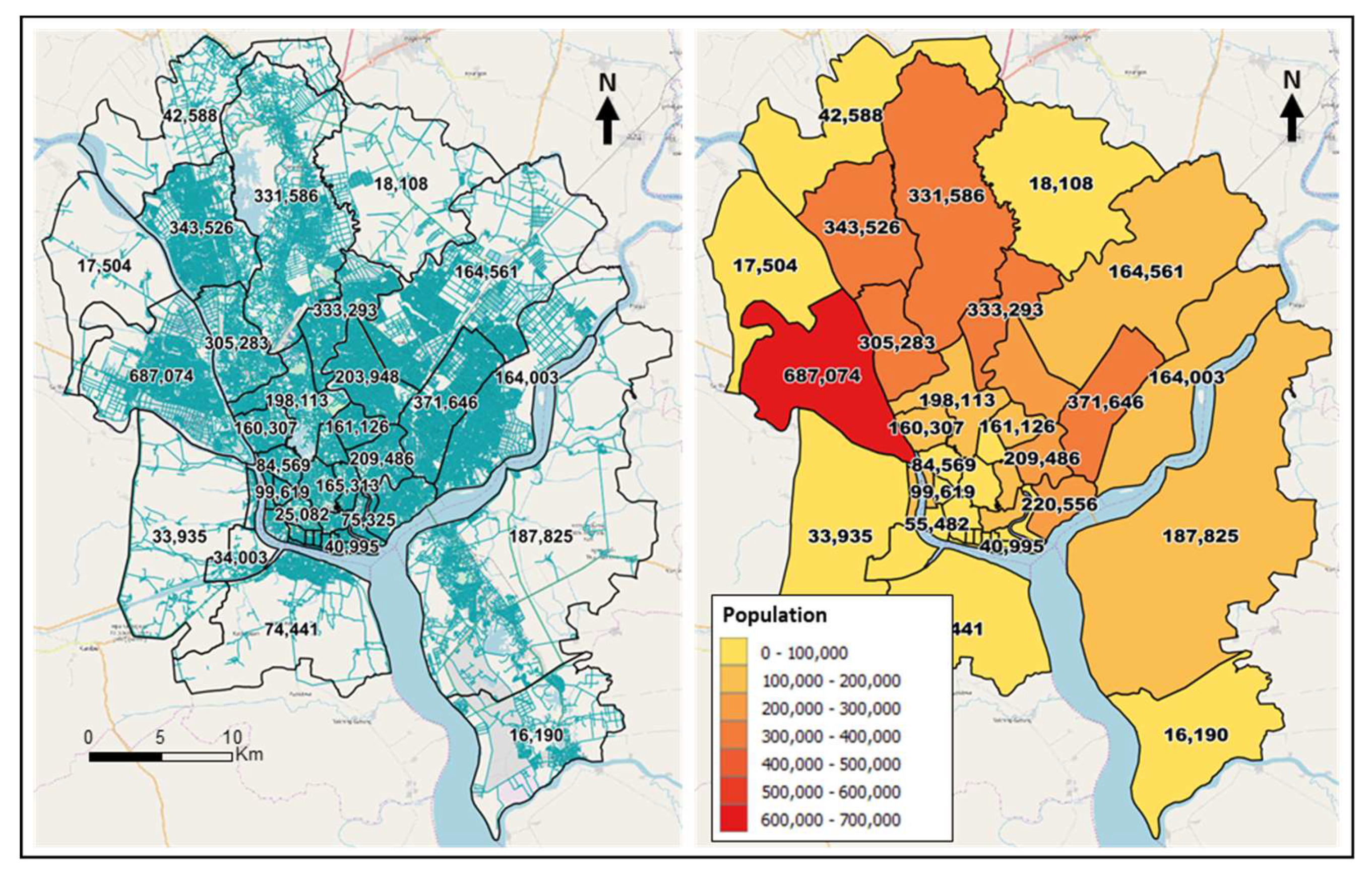



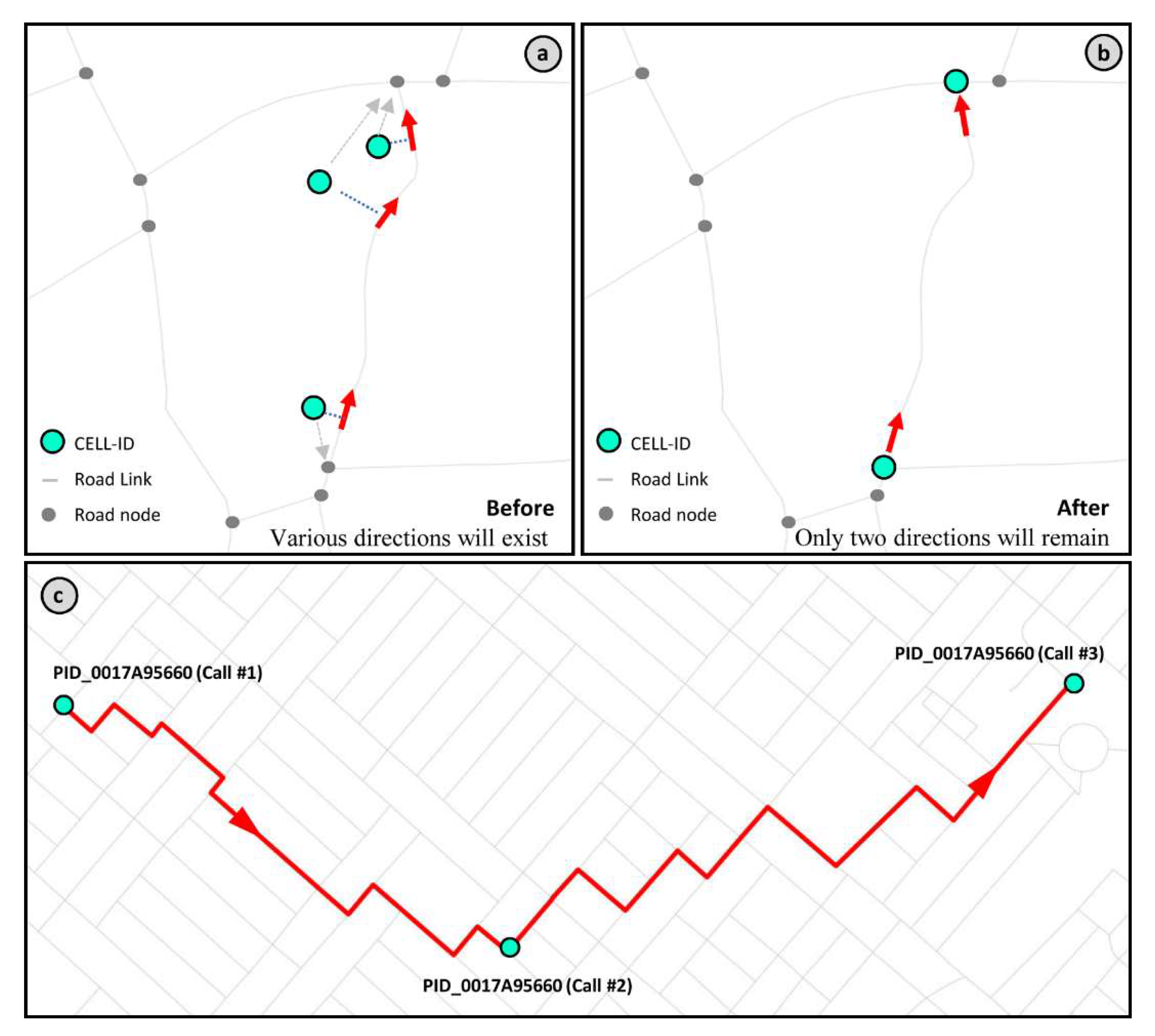

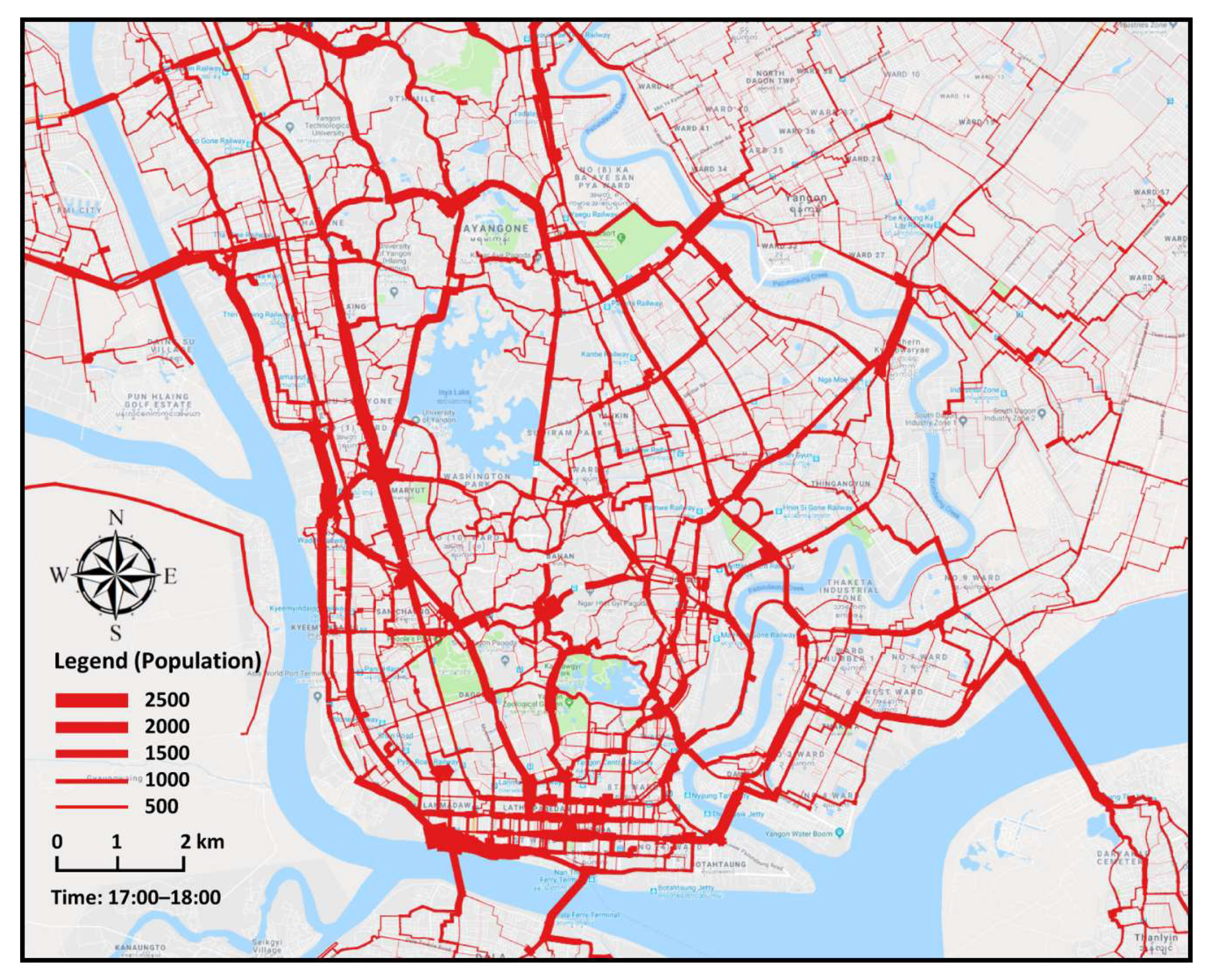

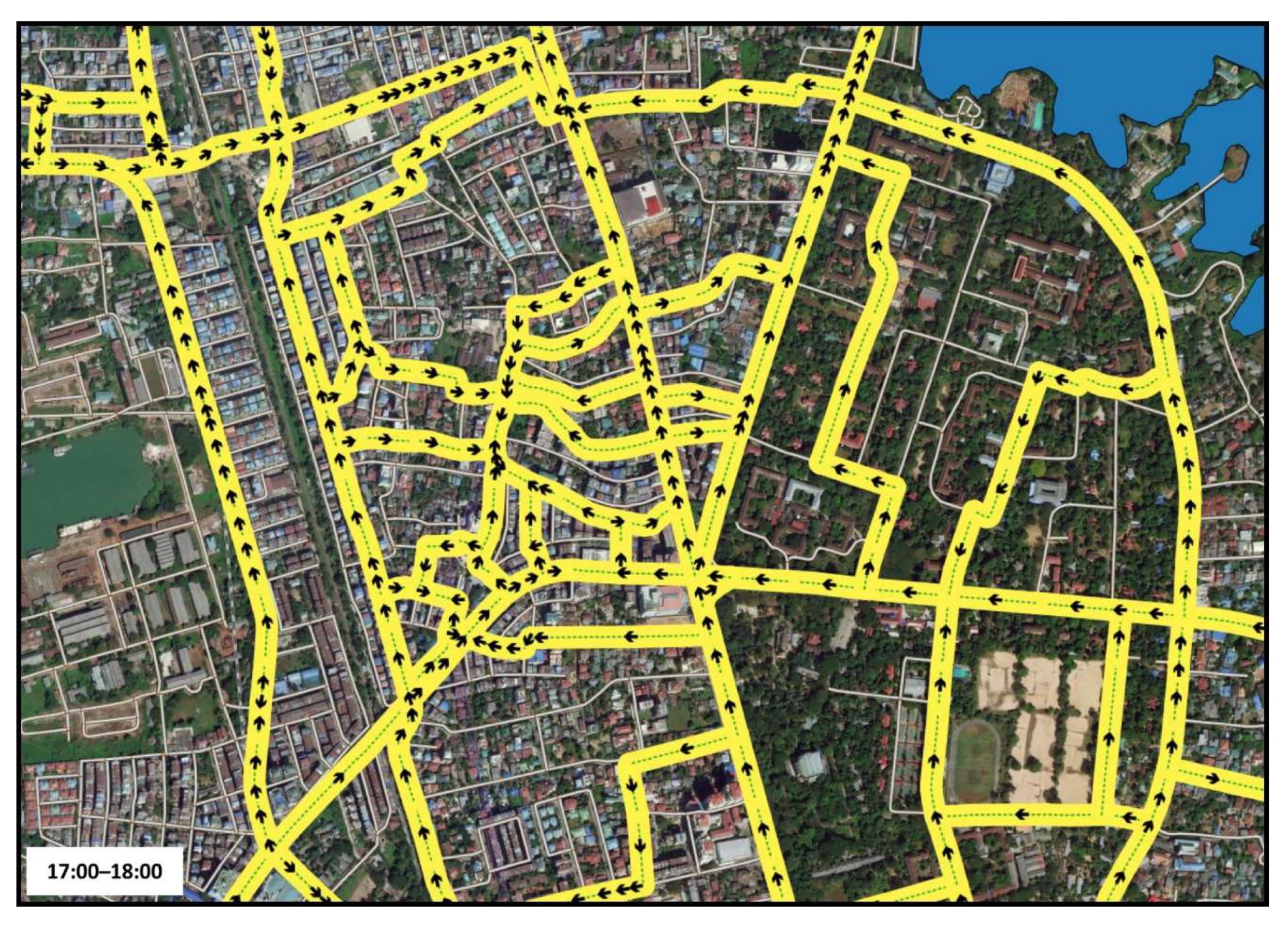
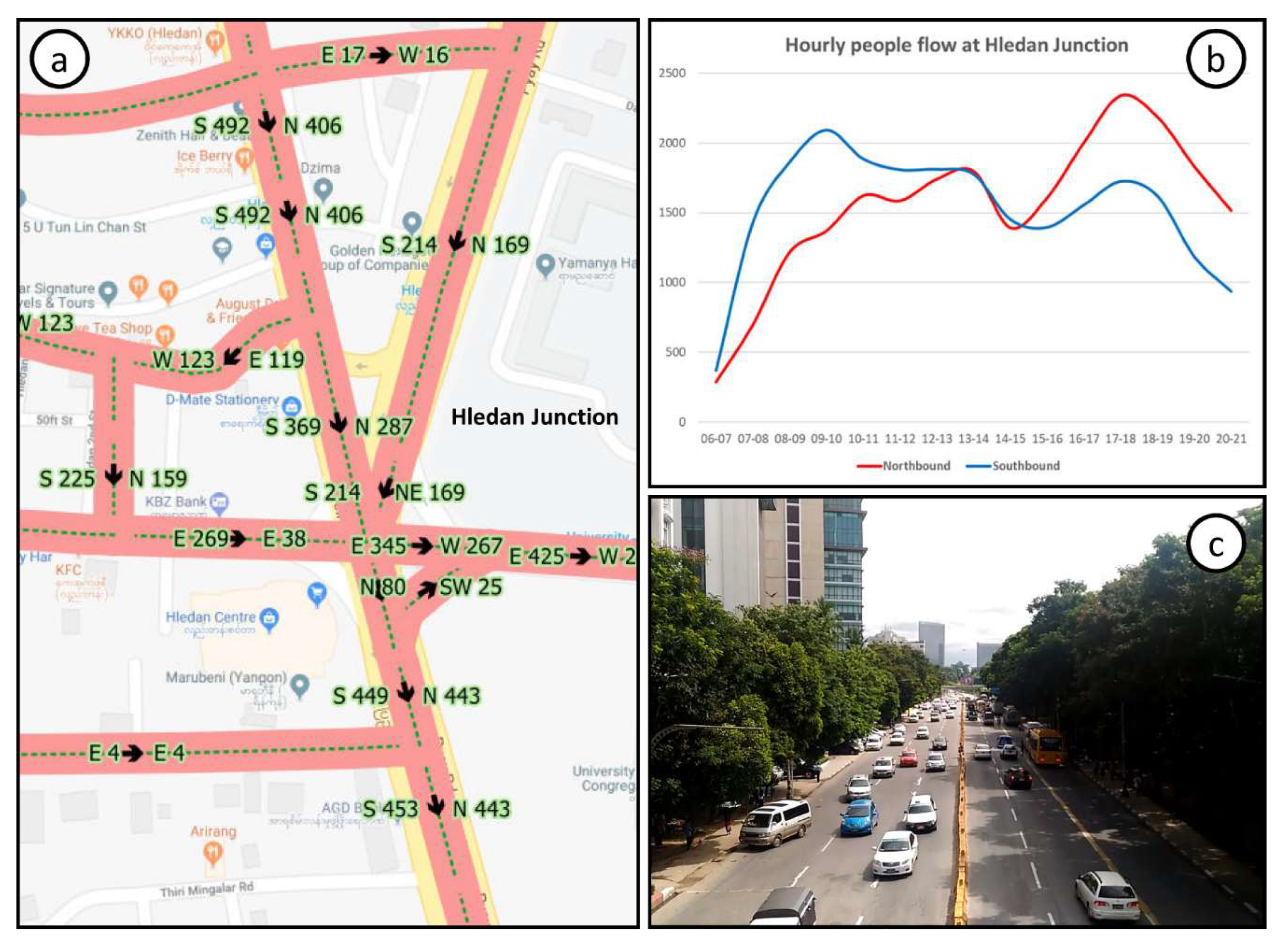
| Dataset Name | Data Source | Acquisition Date | Attribute Information | Purpose |
|---|---|---|---|---|
| MPT CDR | Myanma Posts and Telecommunications (MPT) call-detail records (CDR) for Myanmar | 1 December 2015 to 7 December 2015 | CDR for both voice and data, including text messages Attributes:
| To generate OD pairs for individuals |
| GIS road network | Yangon City Development Committee (YCDC) | 2013 | Road names, type, length, etc. | To compute trip distance, speed, and direction |
| National census | Myanmar Information Management Unit (MIMU) | 2014 |
male, female, and total | To compute home-based magnification factor (h-MF) |
| JICA Transport Surveys Report | Japan International Cooperation Agency (JICA) | Transport surveys conducted between February 2013 and August 2013 |
| Result validation |
© 2018 by the authors. Licensee MDPI, Basel, Switzerland. This article is an open access article distributed under the terms and conditions of the Creative Commons Attribution (CC BY) license (http://creativecommons.org/licenses/by/4.0/).
Share and Cite
Lwin, K.K.; Sekimoto, Y.; Takeuchi, W. Estimation of Hourly Link Population and Flow Directions from Mobile CDR. ISPRS Int. J. Geo-Inf. 2018, 7, 449. https://0-doi-org.brum.beds.ac.uk/10.3390/ijgi7110449
Lwin KK, Sekimoto Y, Takeuchi W. Estimation of Hourly Link Population and Flow Directions from Mobile CDR. ISPRS International Journal of Geo-Information. 2018; 7(11):449. https://0-doi-org.brum.beds.ac.uk/10.3390/ijgi7110449
Chicago/Turabian StyleLwin, Ko Ko, Yoshihide Sekimoto, and Wataru Takeuchi. 2018. "Estimation of Hourly Link Population and Flow Directions from Mobile CDR" ISPRS International Journal of Geo-Information 7, no. 11: 449. https://0-doi-org.brum.beds.ac.uk/10.3390/ijgi7110449





